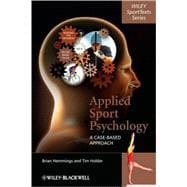
Note: Supplemental materials are not guaranteed with Rental or Used book purchases.
Purchase Benefits
Looking to rent a book? Rent Applied Sport Psychology A Case-Based Approach [ISBN: 9780470725733] for the semester, quarter, and short term or search our site for other textbooks by Hemmings, Brian; Holder, Tim. Renting a textbook can save you up to 90% from the cost of buying.
Dr Brian Hemmings, Sports Psychology Consultant based in Northampton, UK.
Dr Tim Holder, Reader in Applied Sport Psychology, St. Mary's College, Twickenham, UK.
Preface.
Authors’ Biographies.
Acknowledgements.
1 Introduction (Brian Hemmings and Tim Holder).
1.1 The cognitive–behavioural approach.
1.2 Types of assessments and interventions.
1.3 Techniques and skills.
1.4 Reflective practice.
References.
SECTION A Working with Individuals.
2 Enhancing Self-Efficacy in Professional Tennis: Intensive Work for Life on the Tour (Chris Harwood).
2.1 Introduction/background information.
2.2 Initial needs assessment.
2.3 From identified needs into intervention objectives.
2.4 Interventions and monitoring.
2.5 Evaluation of interventions.
2.6 Evaluation of consultant effectiveness/reflective practice.
2.7 Summary.
Questions for students.
References.
3 Managing Distractions in Test Cricket (Brian Hemmings).
3.1 Introduction/background information.
3.2 Initial needs assessment.
3.3 Interventions and monitoring.
3.4 Evaluation of interventions.
3.5 Evaluation of consultant effectiveness/reflective practice.
3.6 Summary.
Questions for students.
References.
4 Consultancy in the Ring: Psychological Support to a World Champion Professional Boxer (Andrew M. Lane).
4.1 Introduction/background information.
4.2 Initial needs assessment.
4.3 Intervention and monitoring.
4.4 Evaluation of intervention.
4.5 Evaluation of consultant effectiveness/refelective practice.
4.6 Summary.
Questions for students.
References.
5 Creating Positive Performance Beliefs: The Case of a Tenpin Bowler (Caroline Marlow).
5.1 Introduction/background information.
5.2 Initial needs assessment.
5.3 Interventions and monitoring.
5.4 Evaluation of intervention.
5.5 Evaluation of consultant effectiveness/reflective practice.
5.6 Summary.
Questions for students.
References.
6 Enhancing Confidence in a Youth Golfer (Iain Greenlees).
6.1 Introduction/background information.
6.2 Initial needs assessment.
6.3 Interventions and monitoring.
6.4 Evaluation of interventions.
6.5 Evaluation of consultant effectiveness/reflective practice.
6.6 Summary.
Questions for students.
References.
SECTION B Working with Teams and Squads.
7 Delivering Sport Psychology to Olympic Rowers: Beyond Psychological Skills Training (Chris Shambrook).
7.1 Introduction/background information.
7.2 Initial needs assessment.
7.3 Interventions and monitoring.
7.4 Evaluation of interventions.
7.5 Evaluation of consultant effectiveness/reflective practice.
7.6 Summary.
Questions for students.
References.
8 Delivering Educational Workshops for Age-Group Rugby League Players: Experiences of a Trainee Sport Psychologist (Jenny Page).
8.1 Introduction/background information.
8.2 Initial needs assessment – season one.
8.3 Intervention and monitoring – season one.
8.4 Evaluation of intervention – season one.
8.5 Needs assessment – season two.
8.6 Intervention and monitoring – season two.
8.7 Evaluation of intervention – season two.
8.8 Summary.
Questions for students.
References.
9 Team Goal Setting in Professional Football (Richard Thelwell).
9.1 Introduction/background information.
9.2 Initial needs assessment.
9.3 Interventions and monitoring.
9.4 Evaluation of intervention.
9.5 Evaluation of consultant effectiveness/reflective practice.
9.6 Summary.
Questions for students.
References.
SECTION C Working with Support Staff.
10 Role Development and Delivery of Sport Psychology at the Paralympic Games (Jonathan Katz).
10.1 Introduction/background information.
10.2 Assessing the requirements/needs of the HQ role.
10.3 Interventions and monitoring.
10.4 Evaluation of interventions/role.
10.5 Evaluation of consultant effectiveness/reflective practice.
10.6 Epilogue.
10.7 Summary.
Questions for students.
References.
11 An Integrated Multi-disciplinary Support Service for an Injured Rubgy Union Lock (Sarah Cecil, Raphael Brandon and James Moore).
11.1 Introduction/background information.
11.2 Initial needs assessment.
11.3 Interventions and monitoring.
11.4 Evaluation of intervention.
11.5 Evaluation of consultant effectiveness/reflective practice.
11.6 Summary.
Questions for students.
References.
12 Developing Coach Education Materials in Table Tennis – Applying a Cyclical Model of Performance (Tim Holder).
12.1 Introduction/background information.
12.2 Initial needs assessment.
12.3 Intervention and monitoring.
12.4 Evaluation of intervention.
12.5 Evaluation of consultant effectiveness/reflective practice.
12.6 Summary.
Questions for students.
References.
Index.
The New copy of this book will include any supplemental materials advertised. Please check the title of the book to determine if it should include any access cards, study guides, lab manuals, CDs, etc.
The Used, Rental and eBook copies of this book are not guaranteed to include any supplemental materials. Typically, only the book itself is included. This is true even if the title states it includes any access cards, study guides, lab manuals, CDs, etc.